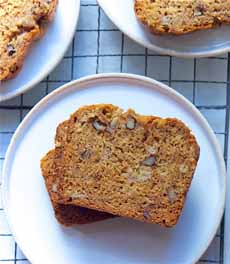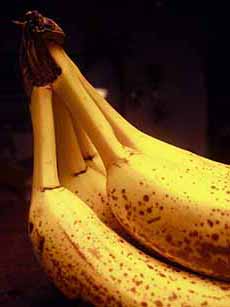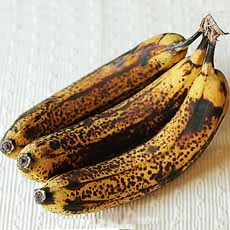RECIPE: Banana Bread Recipe & The History Of Banana Bread
|
It’s February 23rd, National Banana Bread Day, and there’s only one thing for us to do: Bake a loaf, with lots of chocolate chunks. We prefer making ours with overripe bananas [photo #3]: brown peel = more pronounced flavor. Our friend Beth swears by using frozen bananas (we haven’t tried that yet). The recipe is below, after the history of banana bread. May 15th is National Bread Pudding Day. A quick bread. also spelled quickbread, a is bread made with a chemical leavening agent (baking powder or baking soda—the difference). The name refers to the fact that since the bread is made without yeast, it doesn’t need time to rise before baking. Since the “quick” chemical leaveners activate as soon as they are moistened, no kneading or rising is required. Biscuits, cornbread, muffins, popovers, soda breads, and sweet breads such as banana bread fall into the quick bread category. So do zucchini bread, carrot cake, other nut and fruit loaves, coffee cakes made without yeast, pancakes, and waffles. It’s the chemistry of the preparation, not the sweetness, that defines the category. Is carrot cake a quick bread? If you make it in a loaf, yes. If you make it as a layer cake, it’s a cake (it’s the same with banana bread and banana cake). Why ask why? Well…in the 19th century, the descriptive language was looser. Often, the terms cake and pie were used interchangeably. That’s why Boston Cream Pie is a cake, and cheesecake is a pie. But feel free to call a loaf of carrot cake by its proper quick bread name, carrot bread. Thanks to PJ Hamel of King Arthur Flour for her research. |
 [1] King Arthur Flour’s banana bread recipe, below (photo © King Arthur Baking).
|
|
|
The U.S. supply of bananas comes from Central America. There weren’t many bananas in the U.S. until the turn of the 20th century. The fruit ripened and rotted too quickly to travel far by ship. If it was found anywhere, it was in parts of the country closest to Central America. The advent of refrigerated transport at the turn of the 20th century was a boon for lots of perishables. Bananas arrived in cities nationwide and quickly became a breakfast staple. At the time bananas were also used in desserts, but often just as a garnish atop cake or pudding. Beyond that they can differ wildly, reflecting trends of their decades: everything from a sprinkle of sesame seeds or a dollop of apricot jam, crushed pineapple, wheat bran, or grated orange peel (not to mention nuts). Here is more of her research. Our favorite addition, chocolate chunks, came later. Here’s our banana bread-chocolate chunk recipe, which includes a cup of chocolate chunks or chips. For a twist, mix both dark and white chocolate chunks/chips. |
||
|
|
RECIPE: KING ARTHUR FLOUR BANANA BREAD RECIPE Thanks to King Arthur Flour for this banana bread recipe [photo #1], which uses honey plus apricot jam or orange marmalade. Prep time is 20 minutes, bake time is 1 hour 10 minutes. Ingredients For 1 Loaf (18 Slices) 1. PREHEAT the oven to 325°F. Lightly grease a 9″ x 5″ loaf pan; or a 12″ x 4″ tea loaf pan. 2. COMBINE the butter, sugar, vanilla, cinnamon, nutmeg, baking soda, baking powder, and salt in a large bowl, beating until smooth. Add the mashed bananas, jam, honey, and eggs, again beating until smooth. Add the flour, then the walnuts, stirring just until smooth. 3. SPOON the batter into the prepared loaf pan, smoothing the top. Let it rest at room temperature for 10 minutes. |
|
|
4. BAKE the bread for 45 minutes, then gently lay a piece of aluminum foil across the top to prevent over-browning. Bake for an additional 25 minutes (20 minutes if you’re baking in a tea loaf pan). 5. REMOVE the bread from the oven; a long toothpick or cake tester inserted into the center should come out clean, with at most a few wet crumbs clinging to it. The tester shouldn’t show any sign of uncooked batter. If it does, bake the bread for an additional 5 minutes, or until it tests done. 6. ALLOW the bread to cool for 10 minutes in the pan. Remove it from the pan, and cool it completely on a rack. |
||


